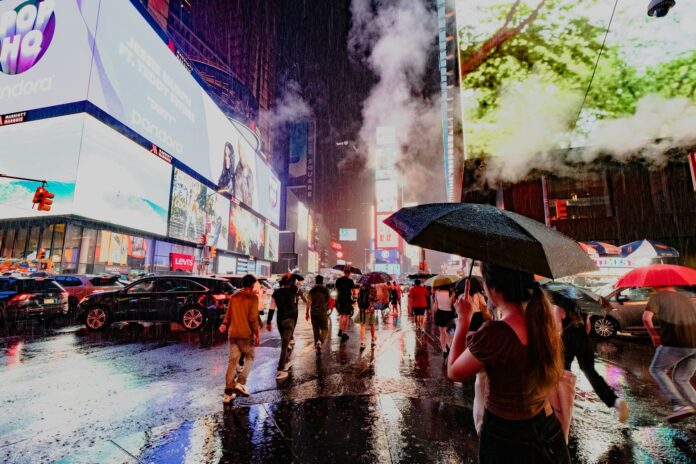It only took one hour.
On the evening of July 14, 2025, 2.07 inches of rain fell on Central Park in just sixty minutes. By the standards of planetary physics, this is a minor redistribution of moisture. By the standards of New York City’s sewage infrastructure, it’s a crisis. Not the poetic kind, not the climate-change-will-affect-our-grandchildren kind. The real kind. The foot-of-water-inside-your-local-pub kind. The stranded-on-the-subway kind. The we-didn’t-budget-for-this kind.
Floodwater didn’t just seep this time; it surged. It poured into subway stations like the city had summoned the wrath of Poseidon and left a crack in the door. Riders clung to poles in waterlogged train cars. Manhattan’s core arteries were choked. Newark and Hoboken turned into bathtub experiments. Two people died in Plainfield. And as usual, the post-mortem was clinical: 16 million gallons pumped from the subway. 6.5 inches of rain in parts of New Jersey. “Record rainfall,” we say. But we said that in 2021 too. And 2023. And last year. The problem is not the surprise. The problem is that we still pretend to be surprised.
New York’s sewer system was built to handle up to 1.75 inches of rainfall per hour. It is a mid-century dream in a 21st-century storm. The 2025 deluge, like Ida before it, simply laughed at the math. Climate change is no longer a prediction. It is a brute fact, and the city’s infrastructure is its most vulnerable punchline. The state has not reimagined the system; it has merely patched it, like a 40-year-old renter pouring coffee grounds down a corroded pipe and hoping for the best.
There’s a term used in disaster studies: disaster amnesia. It refers to the rapidity with which societies forget the lessons of catastrophe. New York is deep in its own blackout of memory. After Hurricane Ida flooded basements and killed eleven people in 2021, there were promises. Better drainage. More green infrastructure. Expanded early warning systems. But by 2025, the main upgrades seem to have occurred in the frequency of the press releases, not the resilience of the pipes. Funding remains paltry. Urban development, meanwhile, continues at full tilt, paving over any surface that might have absorbed a drop.
This is the political economy of drowning. Our response to catastrophe is not investment, but improvisation. Metro-North suspends service. MTA tweets apologies. DOT puts up orange cones. FEMA prepares for the next one. No one wants to say what this really is: a slow collapse wearing a hi-vis vest.
Worse, the city’s most vulnerable residents are once again left to bear the brunt. It’s the bar back wading through ankle-high water at closing time. The nurse who can’t make it to her shift because the 2 train is underwater. The immigrant family on Chestnut Street watching water crawl up to the doorknob. We call these natural disasters, but their outcomes are socially engineered. Floods reveal the contours of inequality like nothing else: who lives in the basement, who gets stuck on the train, who has the means to rebuild.
You would think the wealthiest city in the country—home to billion-dollar condos with biometric security—might have the foresight to keep water out of its transit tunnels. But American infrastructure is a monument to deferred maintenance. The subway needs billions. The sewers need billions. Public housing, public transit, public anything—it all needs billions. The private sector, meanwhile, receives subsidies. Tax breaks. Luxury rezoning. You know the drill.
And so the city floods again. We photograph the waterlogged stairs. We joke about Venice. We hashtag resilience. But the meaning of resilience has quietly shifted. It no longer means building better systems. It means enduring broken ones.
The 2025 floods are not an aberration. They are a preview. They are the opening act in a slow, wet tragedy called “life in the Anthropocene.” What’s striking isn’t the water, but the impotence. The sheer predictability of it all. The sense that, despite the data, the scientists, the visible sky turning green, we still live in a political culture allergic to prevention.
Disaster, in New York, is always treated like a surprise party. And yet it keeps arriving, on time, every year.
But something else seeps in with the water. Not just mold, but possibility. The city has a long tradition of learning late and acting fast. It took a blackout to reform the grid, a blizzard to restructure snow response. Perhaps it will take drowning Penn Station twice in a decade to finally admit that 1.75 inches is no longer a relevant threshold.
The rain will keep coming. The question is whether we finally decide to build a city for the weather we have—not the weather we remember.
